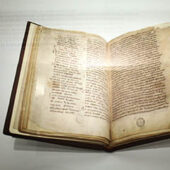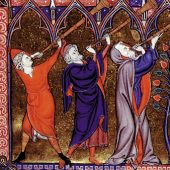Saint Salome’s Resting Place?
A Converted Cave Chapel in the Judean Foothills

The sunken courtyard outside the entrance to the cave of Salome. A small monastery was built here to welcome pilgrims. Courtesy Emil Aladjem, Israel Antiquities Authority.
At the site of Horvat Qasra in the Judean foothills, between the fifth and the eighth centuries, Byzantine Christians frequented a small tomb chapel cut into the limestone hillside. Repurposing what was originally a multi-chambered Judean burial complex, these visitors converted the space into a memorial shrine dedicated to Saint Salome, a figure mentioned in the Gospels as one of Jesus’ disciples. On the interior walls, they carved prayers to “Holy” or “Lady” Salome, titles that implied her saintly status. But who was Saint Salome, and how did this site come to be associated with her?
In the Spring 2024 issue of Biblical Archaeology Review, Joan E. Taylor and Boaz Zissu explore these and other questions surrounding the site at Horvat Qasra and the identity of the figure venerated there, in their article entitled “The Cave of Salome: Tomb of Jesus’s Disciple?”

FREE ebook, Recipes from the BAR Test Kitchen Make your own food from recipes handed down from biblical times. Download now.
The rocky hillside site of Horvat Qasra is about 5 miles from the modern town of Beth Guvrin. Originally, the caves dug there formed a monumental burial complex dating to the early Roman period (first century BCE–second century CE) that was typical of wealthy Jewish tombs of the day. It consisted of six main rooms, two of which contained a number of kokhim, or elongated niches for burials. Another room housed ossuaries—“bone boxes” that contained the bones of individuals previously interred in the tomb. Various items discovered in the complex, from ossuary fragments to oil lamps and stoneware vessels, were all typical of Judean tombs of the first and second centuries.

Interior room within the cave of Salome. A low chancel screen partitions the space, with an altar set up just beyond. Boaz Zissu, Bar-Ilan University.
Outside the tomb entrance, a sunken exterior courtyard was dug into the surface of the hillside. The entrance itself was framed by double colonnades, a roofed vestibule, and a façade that may have been adorned with a Doric-style frieze similar to those known from tomb complexes in Jerusalem, Samaria, and the Hebron Hills. The tomb’s opening was blocked with a large rolling stone.
Beginning in the mid-second century, the tomb complex in the heart of the Judean foothills ceased to be used as a Jewish burial site. It fell into disuse until the fifth century, when Byzantine Christians began the process of converting the space into an underground chapel. In one interior room, an altar was placed behind a low chancel screen. Years’ worth of lamp soot in the cave’s innermost chamber, where an elongated niche likely held the chapel’s reliquary, indicate that this space was a focus of worship. In the exterior courtyard, a small monastery was built.
Throughout the complex, visitors carved crosses and Greek, Aramaic, and Arabic inscriptions into the soft limestone of the cave walls. Several of these address Saint Salome by name; for instance, one plea inscribed within the archway leading to the shrine’s final chamber reads, “Holy Salome, have mercy on Zacharias, son of Cyrillos, Amen.”

In the final chamber is the elongated niche that held the chapel’s reliquary. The black of lamp soot attests to many years of worship here. Boaz Zissu, Bar-Ilan University.
So who was this figure, venerated by pilgrims during the Byzantine period? And how did she come to be associated with this location? There are several figures named Salome in the New Testament and other sources. Perhaps the best-known Salome is the girl who danced before Herod Antipas in the story of the death of John the Baptist (Mark 6:14–29; Matthew 14:1–12); the Gospels identify her only as the daughter of Herodias, but Josephus (Antiquities 18.137) gives her the name Salome. But this figure hardly qualifies as a saint.
Other figures named Salome are known from outside the Bible. In the Protevangelion of James, a second-century work, Salome is the name of a midwife who arrives at the manger shortly after Jesus’ birth. Another Salome appears in the sixth-century History of Joseph the Carpenter as a friend to the holy family during their time in Egypt. But neither of these figures would have been considered saints.
Most likely, then, the Salome in question is one of Jesus’ disciples, a lesser-known figure mentioned in the Gospels. She is listed as one of his women followers who followed him from Galilee to Jerusalem and witnessed the crucifixion (Mark 15:40–41), and she also is identified as a “myrrh-bearer,” one of the women who came to the tomb where Jesus was laid to complete the burial rituals (Mark 16:1–2). This same figure is also identified in some traditions as the mother of James and John, the sons of Zebedee (see Matthew 20:20; 27:56), and at least one fourth-century author, Epiphanius, names her as one of Jesus’ two sisters.

Easter: Exploring the Resurrection of Jesus
In this free eBook, expert Bible scholars offer in-depth reflections on the resurrection.
Such an individual surely warranted saintly status. But how did Saint Salome come to be associated with a burial chapel off the beaten path in the Judean foothills? According to the authors, the most likely possibility is that early Christians identified the name “Salome” (“Shlomit” in Hebrew) on one of the tomb’s earlier Jewish ossuaries and made the connection with Christian tradition on this basis, venerating the bones within the box as the remains of this holy figure.
For more on the cave of Salome at Horvat Qasra, read the article by Joan E. Taylor and Boaz Zissu entitled “The Cave of Salome: Tomb of Jesus’s Disciple?” published in the Spring 2024 issue of Biblical Archaeology Review.
BAS Library Subscribers: Read the full article “The Cave of Salome: Tomb of Jesus’s Disciple?” by Joan E. Taylor and Boaz Zissu in the Spring 2024 issue of Biblical Archaeology Review.
Not a BAS Library or All-Access Member yet? Join today.
This article was originally published in Bible History Daily on March 27, 2024.
Related reading in Bible History Daily
All-Access members, read more in the BAS Library
Not a BAS Library or All-Access Member yet? Join today.
Must-Read Free eBooks
Want more Bible history?
Sign up to receive our email newsletter and never miss an update.
Unlock Unlimited Access to the Bible's Past
Become an All-Access Member to explore the Bible's rich history. Get Biblical Archaeology Review in print, full online access, and FREE online talks. Plus, enjoy special Travel/Study discounts. Don't miss out—begin your journey today!












